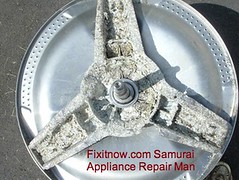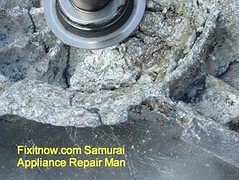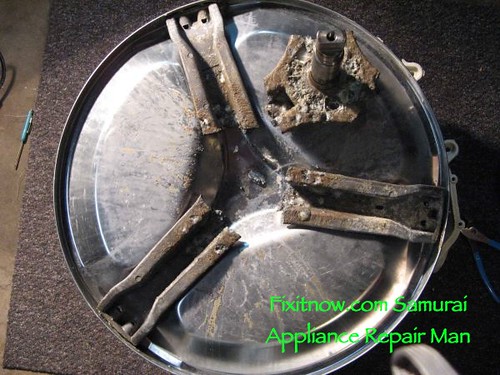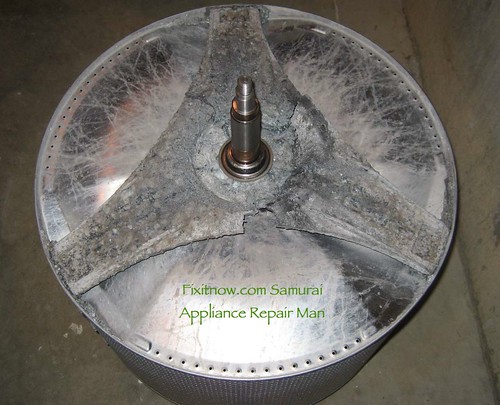Been seeing a rash of galvanic corrosion-induced failures of the drum support spiders in various brands of front loading washers. Affected brands include GE, Whirlpool, and Frigidaire. Since Sears Kenmore brand outsources everything with a Kenmore label, all Kenmore washers are manufactured by one of the three aforementioned companies and will also manifest this same problem (see this topic for more info on who makes Kenmore appliances).
Kicking off the Washer Corrosion Hall of Shame is this bit of metallic misery from a Frikkidaire washer:
The drum support spider in this Frigidaire washer had corroded so much that the hub and drive shaft actually broke off. Note the pitting in the metal. You can see in the closeup that the metal seems to turn into powder. That’s the galvanic corrosion that I be tawkin’ aboot, you dig? It weakened the spider structural strength so much that it failed during use. Ah, Grasshoppah, can you stand with me, our mouths agape at the raw power of chemistry?
Next up is this drum from a GE washer:
Not to be outdone by their competitors, here’s an advanced case of galvanic corrosion in a Whirlpool Duet washer (also sold as the Kenmore HE2/3t):


(click images for larger view)
Whence cometh this galvanic corrosion? Most likely because of dissimilar metals between the spider assembly and the drum setting up a galvanic cell inside the washer. The drum is stainless steel and the spider is aluminum. In the wet environment, the aluminum acts as a sacrificial anode, like the zinc rod in a water heater. Some combinations of detergents, fabric softeners, and water quality conditions may create electrochemical conditions which exacerbate this problem. Can you say, “Design flaw?”
I think the engineers at one of these companies figgered out a way to save a buck two-eighty by using an aluminum drum support spider and the engineers at the other companies just brainlessly copied it without applying gray matter. My Momma always telled me that stupid is as stupid does. I rectum now I see what she be sayin’.
To learn more about your washing machine, or to order parts, click here.





I do not believe that the corrosion shown in the photographs is due to galvanic action. Should it be galvanic action then the majority of the corrosion would be at the junction of the stainless steel and the aluminium i.e. at the ends of the spider arms. I have seen no photographs where this is the case. Additionally the shaft of the spider is steel, this is more ‘noble’ than any of the grades of stainless steel and galvanic corrosion would therefore be most severe at the junction of this shaft and the aluminium of the spider.
Aluminium is corroded when immersed in an aqueous solution with a pH value above about 8.0. All detergents have to be above about 8.0 or they would not work. The Material Safety Data Sheets put out by Proctor and Gamble state that the pH for one of the liquid ‘Tides’ is 8.0 and for one of the ‘Tide’ powdered detergents as 11.0. Bleach, (sodium hypochlorite) is also very corrosive to aluminium. I should add that for corrosion of the spider to take place these levels are considerably above the levels found in a washing machine during the wash/rinse phases of the cycle.
On the spider removed from one of our Frigidaire built Kenmore machines I have measured the diameter of the spider, at the outer surfaces of the recesses close to the centre, it is 3.563 inches. At 1,000 rev/min this equates to a speed, at this point, of 10.6mile/hour. I do not believe that this is sufficient to throw all of the water out of theses recesses at the end of even the fastest spin cycle. This remaining water will contain very, very small percentages of the laundry aids used, soil from the ‘dirty’ laundry, and chemicals from the ‘tap’ water. At this point no damage has occurred, and will not for some time afterwards i.e. until sufficient of the water has evaporated to allow the pH of the remaining mixture to rise above the threshold at which corrosion will occur.
In addition to the possibility of corrosion of the aluminium and steel described above any trapped water, even deficient in corrosion causing chemicals, will still contain remnants of soil. This I believe will lead to the formation of mould, mildew and very offensive odours.
This, I believe, explains how one apparently common complaint is caused, the corrosion, and gives an, at least partial reason, for the many complaints of mold, mildew and foul odours.
Domo for enriching this post with your comments, David!
As a further thought on what the corrosion of these spiders can do I offer the following suggestion.
Where have you seen the words ‘Aluminium Oxide’ before? Could it be on the rear of a piece of orange coloured paper, course on one side, sometimes called ‘sandpaper’?
The corrosion of these spiders causes the formation of, amongst other things, aluminium oxide, the same as is used in ‘sandpaper’. Just think what that, in suspension, in the washing water could do to the soft lips of the shaft seal, and when it gets into the bearings it will also add to the corrosive action of the water leading to the demise of said rotating parts.
Got my new Drum assy +tub(s) from Whirlpool last week. (all paid by warranty) Removed spider from drum and took it to my local powder coating shop and had it done in a nice white pearl! 😀 We’ll see how long this lasts. Got 7 years out of the stock one.
Let us know how it goes. Extra credit for pictures, even more for a video or your repair battle!
Withe reference to the above it has recently come to my attention that Whirlpool have admitted in a Canadian court that:
1. They have altered the material of their spiders, to an aluminium alloy more resistant to corrosion.
2. Altered the design of the spiders to improve drainage.
3. Altered the design of the outer tubs to reduce pooling.
4. Altered the user manuals to give instruction regarding cleaning and introduced cleaning cycles to the machines.
The details can be found on pages 15 to 19 here:
http://classproceedings.ca/files/2012/09/Whirlpool-Certification-Denied-Reasons.pdf
In this document the spiders are referred to as braces or cross pieces.
These modifications were made to reduce the incidences of bio-film build causing odors and corrosion of the spiders.
Please note that this is is the judge’s ‘decision’ and reflects what she understood the Whirlpool representatives to have said.
Should this be correct we should see no Whirlpool spiders fail due to corrosion if the machine was built after 2008. Only time will tell
Great info! Domo for posting that, David. Something needed to change in that design. I wonder it took a Canadian court to get these admissions from Whirlpool?
Samurai Appliance Repair Man
According to the above submission by Whirlpool we should be seeing no corroded spiders from the Duet Sports or the He2’s as these all had the revised material specs and the improved ‘drainage’ fo the spider.
On another site I have seen a comment from an appliance repairer to the effect that he has seen several of these spiders corroded and fractured. What is your experience of these?
Further I am trying to find out if anyone has had any experience(s) with the spiders for the larger Whirlpool built machines that look similar to the ones from the Duet Sports/He2’s. Have you had any experience of these?
I have seen a couple of photographs of spiders removed from the larger He models supposedly built after 2008, but these, although slightly different to the design shown above, (shown in the thread here https://groups.google.com/forum/#!topic/washer-repair/BIwQBQADmWY) are not, at least in my opinion much of an improvement. Do you have any experience(s) with these?
Thank you for your time.